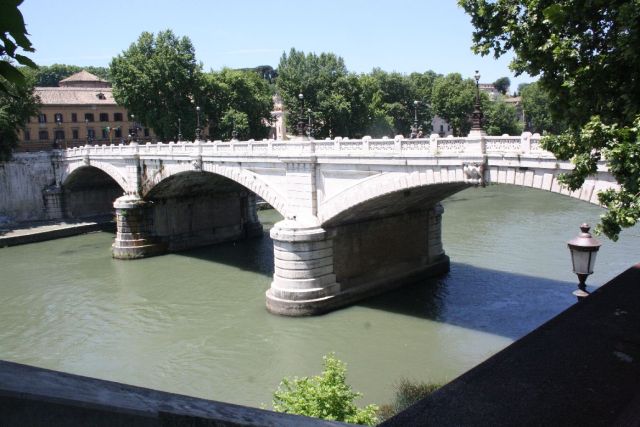See Bridges Over the Tiber -1 for location map.
The final installment of Bridges Over the Tiber brings us to the six bridges built in the 20 th Century, which can be grouped in three pairs: two copies of the ancient Ponte Fabricio, two based on the medieval and 19th Century arch bridges, and two of clearly 20th Century design.
The Ponte Sublicio (1) – 1918, and Ponte Amedeo Savoia Aosta (9) 1939 both make clear reference to the ancient Ponte Fabricio. The Ponte Sublicio is on the site of the earliest bridge over the Tiber, built around 642 BC, but there are now no remains of the original bridge.
The Ponte Amedeo Savoia Aosta was constructed between 1939 and 1942 and consists of three segmental masonry arches covered in white marble.
The Ponte Mazzini (8) and Ponte Matteotti (16) were constructed in 1904 and 1929 respectively. The Ponte Mazzini, with three flat segmental arches supported on solid piers, follows in the tradition of the late 19th century bridges, such as the Ponte Vittoria Emanuele II and the Ponte Umberto I.
The Ponte Matteotti with its circular openings either side of the central span and semi-circular arches reflects the design of the medeival Ponte Sisto, although to my mind a good deal less elegantly.
The final two bridges are the Ponte Risorgimento (17) and the Ponte Pietro Nenni (15). The Ponte Risorgimento has many visual similarities to flat segmental arches of the late 19th Century, but it is an early example of the use of reinforced concrete, having been constructed using the system of François Hennebique, starting in 1909. The designers have taken advantage of the reinforced concrete system with a larger span and more slender crown than could be achieved with masonry construction.
The Ponte Pietro Nenni was constructed between 1969 and 1972 and is the only modern design of the 17 structures. Constructed in post-tensioned concrete, the slender slab deck supported on Y shaped piers is totally different to the older arch structures, but the attention to detail has in my opinion resulted in a design that is in keeping with its older neighbours.




















